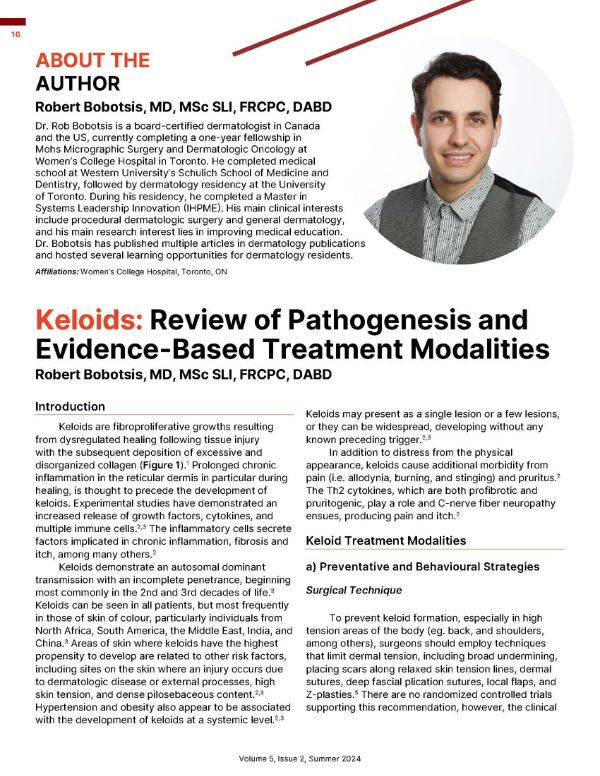Keloids: Review of Pathogenesis and Evidence-Based Treatment Modalities
Abstract
Keloids are fibroproliferative growths resulting from dysregulated healing following tissue injury with the subsequent deposition of excessive and disorganized collagen (Figure 1). Prolonged chronic inflammation in the reticular dermis in particular during healing, is thought to precede the development of keloids. Experimental studies have demonstrated an increased release of growth factors, cytokines, and multiple immune cells. The inflammatory cells secrete factors implicated in chronic inflammation, fibrosis and itch, among many others.
Keloids demonstrate an autosomal dominant transmission with an incomplete penetrance, beginning most commonly in the 2nd and 3rd decades of life. Keloids can be seen in all patients, but most frequently in those of skin of colour, particularly individuals from North Africa, South America, the Middle East, India, and China. Areas of skin where keloids have the highest propensity to develop are related to other risk factors, including sites on the skin where an injury occurs due to dermatologic disease or external processes, high skin tension, and dense pilosebaceous content. Hypertension and obesity also appear to be associated with the development of keloids at a systemic level. Keloids may present as a single lesion or a few lesions, or they can be widespread, developing without any known preceding trigger.
In addition to distress from the physical appearance, keloids cause additional morbidity from pain (i.e. allodynia, burning, and stinging) and pruritus. The Th2 cytokines, which are both profibrotic and pruritogenic, play a role and C-nerve fiber neuropathy ensues, producing pain and itch.
References
Lee CC, Tsai CH, Chen CH, Yeh YC, Chung WH, Chen CB. An updated review of the immunological mechanisms of keloid scars. Front Immunol. 2023;14:1117630. doi:10.3389/fimmu.2023.1117630
Hawash AA, Ingrasci G, Nouri K, Yosipovitch G. Pruritus in keloid scars: mechanisms and treatments. Acta Derm Venereol. 2021;101(10):adv00582. doi:10.2340/00015555-3923
Ogawa R. The most current algorithms for the treatment and prevention of hypertrophic scars and keloids: a 2020 update of the algorithms published 10 years ago. Plast Reconstr Surg. 2022;149(1):79e-94e. doi:10.1097/prs.0000000000008667
Delaleu J, Charvet E, Petit A. Keloid disease: review with clinical atlas. Part I: definitions, history, epidemiology, clinics and diagnosis. Ann Dermatol Venereol. 2023;150(1):3-15. doi:10.1016/j.annder.2022.08.010
Ekstein SF, Wyles SP, Moran SL, Meves A. Keloids: a review of therapeutic management. Int J Dermatol. 2021;60(6):661-671. doi:10.1111/ijd.15159
Hsu KC, Luan CW, Tsai YW. Review of silicone gel sheeting and silicone gel for the prevention of hypertrophic scars and keloids. Wounds. 2017;29(5):154-158.
O’Brien L, Jones DJ. Silicone gel sheeting for preventing and treating hypertrophic and keloid scars. Cochrane Database Syst Rev. 2013;2013(9):Cd003826. doi:10.1002/14651858.CD003826.pub3
Walsh LA, Wu E, Pontes D, Kwan KR, Poondru S, Miller CH, et al. Keloid treatments: an evidence-based systematic review of recent advances. Syst Rev. 2023;12(1):42. doi:10.1186/s13643-023-02192-7
Shin JY, Kim JS. Could 5-fluorouracil or triamcinolone be an effective treatment option for keloid after surgical excision? A meta-analysis. J Oral Maxillofac Surg. 2016;74(5):1055-1060. doi:10.1016/j.joms.2015.10.002
Shin JY, Lee JW, Roh SG, Lee NH, Yang KM. A comparison of the effectiveness of triamcinolone and radiation therapy for ear keloids after surgical excision: a systematic review and meta-analysis. Plast Reconstr Surg. 2016;137(6):1718-1725. doi:10.1097/prs.0000000000002165
van Leeuwen MC, Bulstra AE, Ket JC, Ritt MJ, van Leeuwen PA, Niessen FB. Intralesional cryotherapy for the treatment of keloid scars: evaluating effectiveness. Plast Reconstr Surg Glob Open. 2015;3(6):e437. doi:10.1097/gox.0000000000000348
Hietanen KE, Järvinen TA, Huhtala H, Tolonen TT, Kuokkanen HO, Kaartinen IS. Treatment of keloid scars with intralesional triamcinolone and 5-fluorouracil injections - a randomized controlled trial. J Plast Reconstr Aesthet Surg. 2019;72(1):4-11. doi:10.1016/j.bjps.2018.05.052
Saleem F, Rani Z, Bashir B, Altaf F, Khurshid K, Pal SS. Comparison of efficacy of intralesional 5-fluorouracil plus triamcinolone acetonide versus intralesional triamcinolone acetonide in the treatment of keloids. Journal of Pakistan Association of Dermatologists. 2018;27(2):114-119.
Srivastava S, Patil AN, Prakash C, Kumari H. Comparison of intralesional triamcinolone acetonide, 5-fluorouracil, and their combination for the treatment of keloids. Adv Wound Care (New Rochelle). 2017;6(11):393-400. doi:10.1089/wound.2017.0741
Huu ND, Huu SN, Thi XL, Van TN, Minh PPT, Minh TT, et al. Successful treatment of intralesional bleomycin in keloids of Vietnamese population. Open Access Maced J Med Sci. 2019;7(2):298-299. doi:10.3889/oamjms.2019.099
Khan HA, Sahibzada MN, Paracha MM. Comparison of the efficacy of intralesional bleomycin versus intralesional triamcinolone acetonide in the treatment of keloids. Dermatol Ther. 2019;32(5):e13036. doi:10.1111/dth.13036
Sharma S, Vinay K, Bassi R. Treatment of small keloids using intralesional 5-fluorouracil and triamcinolone acetonide versus intralesional bleomycin and triamcinolone acetonide. J Clin Aesthet Dermatol. 2021;14(3):17-21.
Mankowski P, Kanevsky J, Tomlinson J, Dyachenko A, Luc M. Optimizing radiotherapy for keloids: a meta-analysis systematic review comparing recurrence rates between different radiation modalities. Ann Plast Surg. 2017;78(4):403-411. doi:10.1097/sap.0000000000000989
Liu EK, Cohen RF, Chiu ES. Radiation therapy modalities for keloid management: a critical review. J Plast Reconstr Aesthet Surg. 2022;75(8):2455-2465. doi:10.1016/j.bjps.2022.04.099
Wang J, Wu J, Xu M, Gao Q, Chen B, Wang F, et al. Combination therapy of refractory keloid with ultrapulse fractional carbon dioxide (CO(2)) laser and topical triamcinolone in Asians-long-term prevention of keloid recurrence. Dermatol Ther. 2020;33(6):e14359.
Abd El-Dayem DH, Nada HA, Hanafy NS, Elsaie ML. Laser-assisted topical steroid application versus steroid injection for treating keloids: a split side study. J Cosmetic. Dermatol. 2020; 20(1):138–42
Gold MH, Berman B, Clementoni MT, Gauglitz GG, Nahai F, Murcia C. Updated international clinical recommendations on scar management: part 1--evaluating the evidence. Dermatol Surg. 2014;40(8):817-824. doi:10.1111/dsu.0000000000000049
Gold MH, McGuire M, Mustoe TA, Pusic A, Sachdev M, Waibel J, et al. Updated international clinical recommendations on scar management: part 2--algorithms for scar prevention and treatment. Dermatol Surg. 2014;40(8):825-831. doi:10.1111/dsu.0000000000000050
Ogawa R, Akita S, Akaishi S, Aramaki-Hattori N, Dohi T, Hayashi T, et al. Diagnosis and treatment of keloids and hypertrophic scars-Japan Scar Workshop Consensus Document 2018. Burns Trauma. 2019;7:39. doi:10.1186/s41038-019-0175-y
Juckett G, Hartman-Adams H. Management of keloids and hypertrophic scars. Am Fam Physician. 2009;80(3):253-260.
Lv K, Xia Z. Chinese expert consensus on clinical prevention and treatment of scar. Burns Trauma. 2018;6:27. doi:10.1186/s41038-018-0129-9


